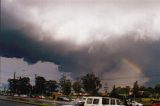and Chasing
[Index][Archives]
Severe Thunderstorm Images of the Month Archives - 2000
Other years: [1997][1998][1999][2000][2001][2002][2003][2004][2005][2006][2007][2008][2009][2010]
| Storm News and Chasing [Index][Archives] |
Severe Thunderstorm Images of the Month Archives - 2000 Other years: [1997][1998][1999][2000][2001][2002][2003][2004][2005][2006][2007][2008][2009][2010] |
|
Severe Thunder- storm images of the month: December 2000 |
No images selected for December 2000. |
|
Severe Thunder- storm images of the month: November 2000 This months photos |

The 25th October 2000 really fired up in spectacular ways in NE NSW and SE QLD. Thunderstorms were widespread and in places severe. A large line of severe storm activity spread through the Richmond Valley of NSW, from Casino to the coast producing this magnificent shelf cloud formation photographed just south of Alstonville. On the northern flank (right in the second photo) many intersting base lowerings occurred which are not always associated with shelf clouds, and may in fact have been a wall cloud. Refer to the full report for details. Later on a second shelf cloud moved through the region and gave on nice lightning show as it approached. |
|
Severe Thunder- storm images of the month: May 2000 This months photos |




|
|
Document: arc2000.htm
Updated: 31st January, 2005 |
[Australian Severe Weather index] [Copyright Notice] [Email Contacts] [Search This Site] |